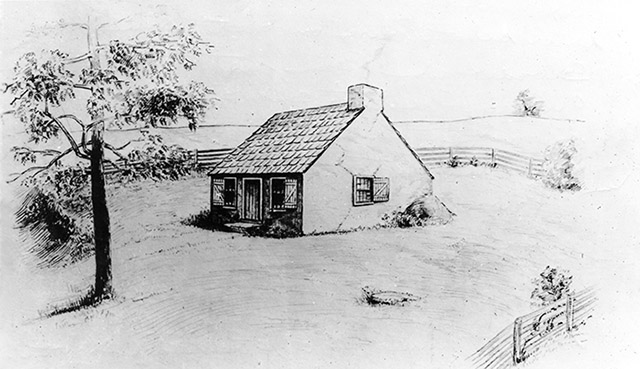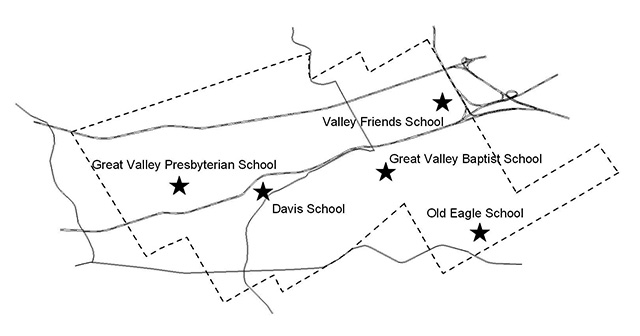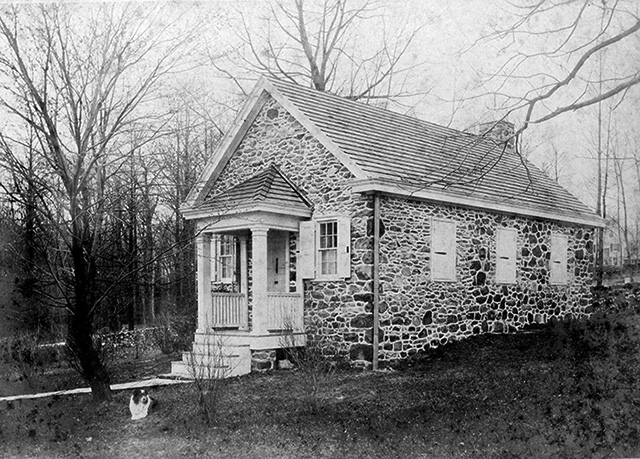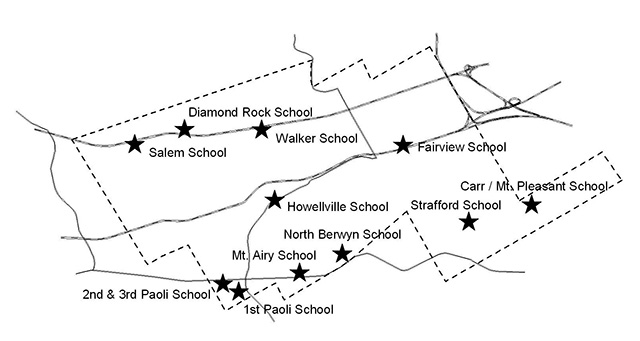|
Home : Quarterly Archives : Volume 44 |
Tredyffrin Easttown Historical Society |
|
Source: Winter/Spring 2007 Volume 44 Numbers 1&2, Pages 32–36 Tredyffrin Schools From the early times of Tredyffrin Township the residents of the township provided for the schooling of their children. Generally, the earliest schools were associated with a church or meeting. Great Valley Baptist School, Great Valley Presbyterian School, and Valley Friends, were established in the first quarter of the 18th century. One exception at that time was the Davis School near Howellville. The land for this neighborhood school was leased from the Davis family for a 999 year term with a rent of one peppercorn.
The Davis School at Howelville The first common schools were called “pay” schools: the usual fee was three cents a day. Pupils were responsible for providing their own books and slates. Local farmers would supply turkey or goose feathers for pens and it was one of the schoolmaster's jobs to sharpen them. School furnishings were very crude: split log benches, a high wooden desk and stool for the schoolmaster, and often, oiled paper at the windows to keep out the rain and let in the light. The schools were at first heated by fireplaces; later an iron plate stove was used. Logs were supplied by the pupils' fathers, and chopped into firewood by the older boys during recess or after school. Ink was made by soaking a few bruised nut galls and rusty nails in a pail of water.
The 18th Century Schools Old Eagle School During the 1750s and 60s a number of German Lutherans moved into the vicinity of the Spread Eagle Inn. In 1765 Jacob Sharraden deeded one acre of his farm as a place for school and church services to a number of trustees. A log meeting house was erected slightly north of the present schoolhouse. Adjoining is the graveyard which provided the final resting place for some early settlers and several Revolutionary War soldiers who died during the Valley Forge encampment (1777 -1778).
Old Eagle School c. 1900 Shortly after the Revolution the old log school was replaced by a stone structure. It was about half the size of the present building and faced west with a double-door entrance and side-sash windows on either side. Inside there was a fireplace for heat, desks along the walls and benches constructed from split logs. Fees to attend Eagle School were either three cents a day or $2.00 for a quarter. If parents were unable to pay tuition, the Commissioners of Chester County customarily supplied funds for those pupils - $12 for 10 students in 1830 and $14 in 1832. 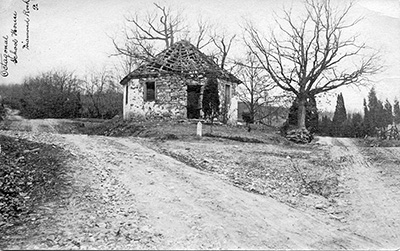
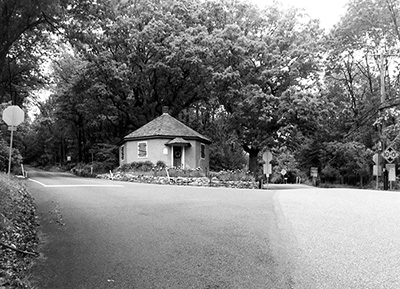
Diamond Rock School The Diamond Rock or Octagonal School, located at the junction of Diamond Rock and Yellow Springs Roads, opened on September 21st 1818. George Beaver had donated the plot of land for the school and a group of neighbors, many of who were Mennonites, signed a subscription list to cover the cost which came to a total of $260.91. Donations of materials and labor were supplied by those unable to supply money. Pupils learned to read from books brought from home. Writing, grammar, mathematics (including surveying), geography, history, and spelling were taught at this and other schools. Spelling skill was important for the Friday afternoon spelling bee was often attended by neighbors.
19th century schools The Carr School 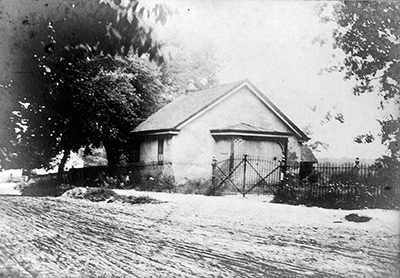
Carr School, 1898 James Carr called a meeting of the neighbors of “The Hill” or “Carr's Hill” (present day Mount Pleasant) on March 14th 1832 for the purpose of selecting trustees for a new school. Old Eagle School had become too small and travel distances to existing schools were too great for many children. Stephen Stephen, James and Martha Carr, and Jesse and Sarah Wharton each deeded small “cornering” sections to create the school lot. In addition to schooling, the nearly square building was the site of religious services that were frequently scheduled for “early candle light.” Common School Act, 1834 On April 1,1834 the Pennsylvania Legislature enacted “An Act to Establish a General System of Education by Common Schools.” In November the citizens of Tredyffrin Township voted to accept the provision of the Common School Act. Trustees were replaced by an elected school board and taxes and state subsidy replaced school tuition. The public school system then included: Howellville (Davis), Eagle, Carr, Presbyterian, Baptist (Union), and Friends. In 1853 the Mount Airy School in Daylesford was built. Four years later a two-story house was built at Howellville to replace the old school. 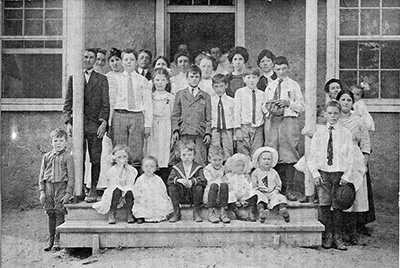
Walker School c. 1912 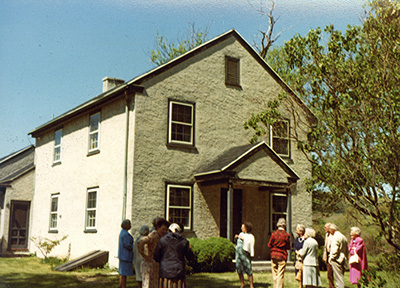
Walker School 1981 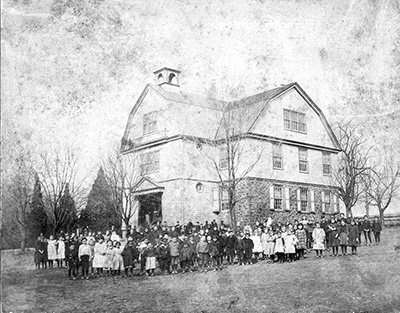
Strafford School c. 1900 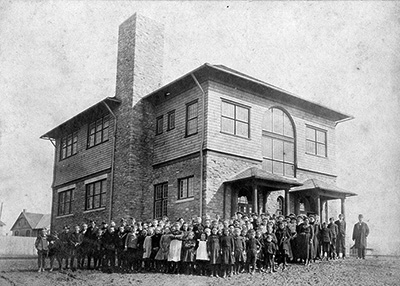
Paoli School c. 1902 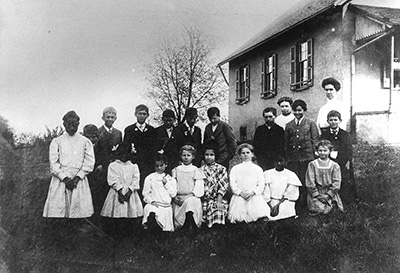
Presbyterian School 1909 During the Civil War Diamond Rock School was closed and replaced by Walker School on the east end of Yellow Springs Road and Salem on the west. Walker was named for the family who originally owned the site. Salem was named for its proximity to the Salem Methodist Church but was not sponsored by the congregation. Locally Salem was known as the Tablet School after an early post office and also for a label on a cracker tin sold in a nearby store. Walker was probably typical of schools of the period: a bell on the roof, outdoor sanitary facilities, no water available except if carried in a bucket or milk can by attending boys. Inside were nailed down desks, a piano and a pot-bellied stove. In the late 1860s the School Board decided to replace the Carr School. Mr. H. Fritz, the low bidder, received the contract for $1,513.35. The Mt. Pleasant (second Carr) School was situated just east of the old school which it replaced. The new school, a frame building with two classrooms on the first floor, was served by a single teacher for its eight grades of pupils. Another classroom was later added on the second floor. The last several decades of the nineteenth century were times of expansion for the Tredyffrin School System. Fairview School, east of the present day Gateway Shopping Center, replaced the Baptist and Friends Schools. In 1872 a new school was built at Upper Gulph and West Valley Roads replacing the Eagle School and soon became known as the Strafford School. This school burned down in 1885 and was rebuilt on the same site with one having four classrooms on the first floor, and two more and an assembly room on the second. North Berwyn was constructed in 1892 on the southeast corner of Howellville and Conestoga Roads as a one-room school but was later expanded into four classrooms. Mt. Airy closed since Paoli had a school - first on Maple Avenue and then on Chestnut Street. At the turn of that century students were attending classes in eight schools: Presbyterian, Salem, Walker, Strafford, Fairview, North Berwyn, Paoli, and Old Mt. Pleasant which was replaced with a larger building in 1903. High Schools Public education for the primary levels had existed for over half a century when the Pennsylvania Legislature authorized in 1893 a law to permit high schools in districts with a population over five thousand. Two years later this provision was expanded to include all districts. In two more years Tredyffrin High School was established and met first in the west room on the second floor of Strafford School. In 1902 a new Paoli School was built on South Valley Road and Tredyffrin High moved into a classroom on the first floor. Also at that time the course was expanded from 2 to 3 years of instruction. 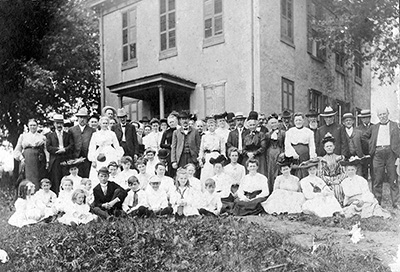
Howellville School Reunion 1904 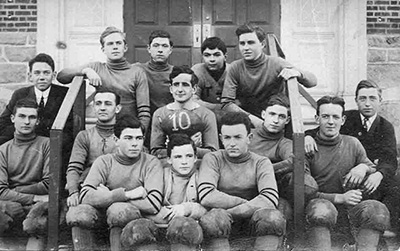
T-E football team, 1910 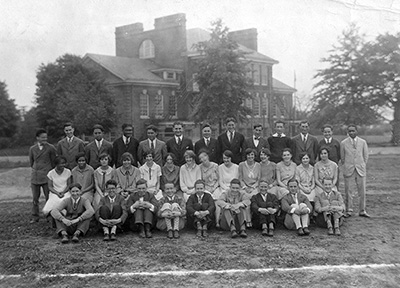
Tredyffrin-Easttown High School Class of 1927 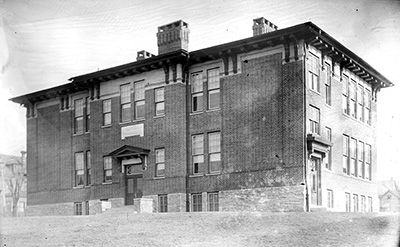
Berwyn Primary School / Lincoln Highway School In 1907 the General Assembly passed a law that allowed two or more adjoining townships to join together and build and maintain a high school. The Tredyffrin School Board met with its counterpart in Easttown and subsequently the Tredyffrin-Easttown Joint High School was created in 1908. Certainly this was an exciting time as this was the first joint high school created in the Commonwealth of Pennsylvania. Salem and Presbyterian added “an important advance” in 1913 - some warm food at lunch-time. At Salem pupils prepared and served the warm lunch. Canning vegetables in the fall for winter lunches was another feature of the program which soon was adopted by other schools. Then in 1922 the Howellville School was destroyed by fire and in 1923 Walker closed after a storm removed its roof and blew the bell and tower into an adjacent field. These losses led to overcrowding. To remedy the situation a new Strafford School was constructed in 1927 and, in the same year, another in Paoli on Central Avenue. With the opening of these two new schools the last one-room schoolhouses, Fairview and Presbyterian, were closed. In 1932 North Berwyn closed and an old school building named the Lincoln Highway School was rented from Easttown. The school board proposed segregating the schools, but after a long fight, the plan was withdrawn (see the article on “The School Fight” for details). Salem School closed around 1939. The following year the 8-4 grade plan was changed to a 6-3-3 system. With the shift a junior high was established and connected to the high school. The post-World War II period was one of mushrooming growth of the school population. The Pennsylvania General Assembly in 1947 and 1951 allowed districts to merge at the elementary level in a similar way to that of the high schools. The Tredyffrin and Easttown School Districts consolidated in 1953. Five new elementary schools and a new junior high were added (Devon, Valley Forge, Hillside, New Eagle, Beaumont, and Valley Junior High School). In 1955 Conestoga High School replaced the existing T-E High School. It expanded twice within twelve years and for a time included students who would later become those of the Great Valley District. The curriculum has continued to expand and offer more options to the students resulting in one of the highest-ranking schools in the nation. In 2002 twenty-two Conestoga students were named national merit finalists. The aim of continued and enhanced excellence by the school district is shown by its mission statement: “raising our measure of excellence to global standards and drawing on our partnerships with home and community, the Tredyffrin / Easttown School District is committed to empower all of our students as self-directed, creative lifelong learners and responsible citizens who flourish in a diverse and dynamic world, by providing them with a strong foundation of knowledge, skills, and experiences through the use of innovative and conventional methods, technologies, and assessments.” |
| Previous Article ⇐ ⇒ Next Article |
